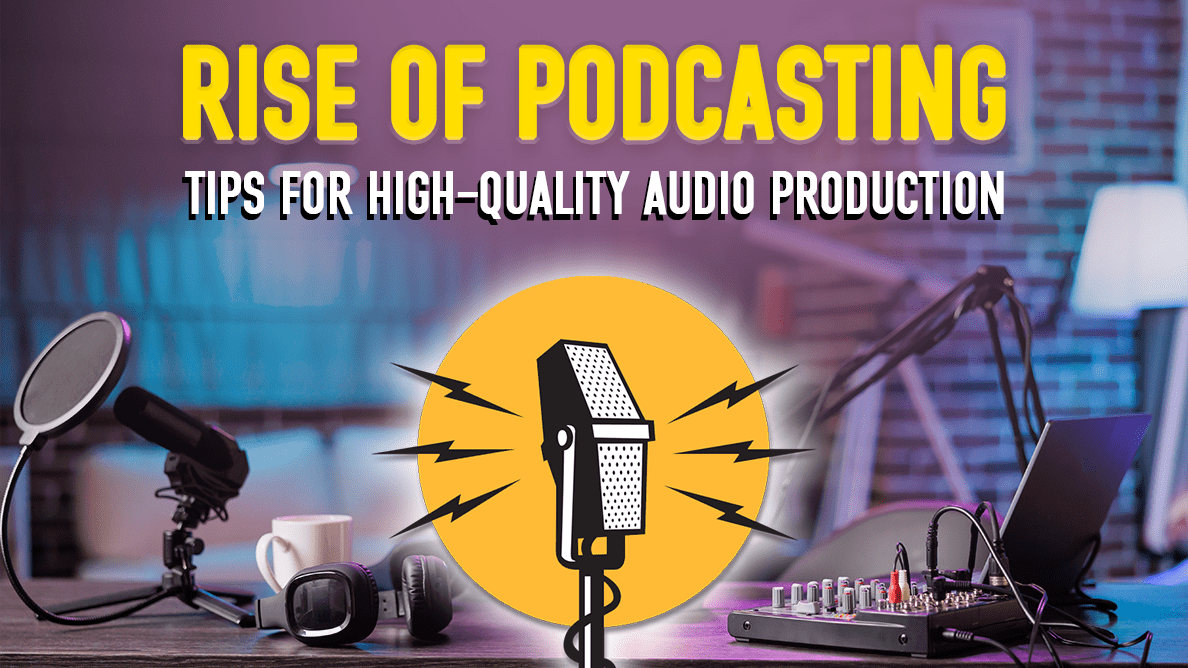Introduction:
In the digital age, the rise of podcasting has become a cultural phenomenon, offering a platform for individuals and organizations to share stories, insights, and conversations with a global audience. While compelling content is the heart of any successful podcast, the quality of audio production plays a pivotal role in capturing and retaining listeners. In this exploration, we delve into the art of high-quality audio production for podcasts, offering tips and insights for creators looking to make their mark in this dynamic and competitive medium.
Invest in Quality Microphones:
The foundation of high-quality audio production begins with the microphone. Investing in a good-quality microphone is crucial for capturing clear and crisp sound. Consider dynamic microphones for individual speakers or podcast hosts and condenser microphones for capturing a broader range of sound in a studio setup. Popular microphone options include the Shure SM7B, Audio-Technica ATR2100x-USB, and the Blue Yeti.
Select a Quiet Recording Space:
Background noise can significantly impact the overall quality of your podcast. Choose a quiet recording space, preferably one with minimal ambient noise. Soundproofing the room or using noise-canceling technologies can help eliminate unwanted distractions and ensure a clean audio recording. Pay attention to factors such as air conditioning, appliances, and external sounds that could disrupt your recording.
Use Pop Filters and Windshields:
Pop filters and windshields are essential accessories for maintaining a consistent and smooth audio recording. Pop filters help minimize plosive sounds (like “p” and “b” sounds) that can cause distortion, while windshields are particularly useful for outdoor or on-location recordings, reducing wind noise and other environmental interferences.
Optimize Microphone Placement:
Proper microphone placement is crucial for capturing clear and natural-sounding audio. Ensure that the microphone is positioned correctly, usually a few inches away from the speaker’s mouth. Experiment with angles and distances to find the optimal setup for your microphone, considering the type of microphone and the speaker’s voice.
Record in a Lossless Format:
When recording your podcast episodes, opt for lossless audio formats to preserve the highest possible audio quality. Common lossless formats include WAV and FLAC. While these files may be larger than compressed formats like MP3, they maintain the integrity of the original recording, offering better post-production flexibility and ensuring a higher-quality final product.
Mind Your Levels and Gain:
Properly setting microphone levels and gain is essential for achieving a balanced and distortion-free audio recording. Avoid recording at levels that peak or clip, as this can result in distorted and unpleasant sound. Monitor your recording levels during the recording process and adjust gain settings to ensure a clean and clear audio signal.
Edit with Precision:
Post-production editing is where you can refine and polish your podcast’s audio quality. Use editing software to eliminate background noise, adjust levels, and fine-tune the overall sound. Pay attention to pacing, transitions, and the removal of any unnecessary pauses or filler words. Software like Audacity, Adobe Audition, or GarageBand can be valuable tools for editing and enhancing your podcast audio.
Consider Audio Processing:
Applying subtle audio processing techniques can enhance the overall sound quality of your podcast. Compression can help even out loud and soft parts of the recording, while equalization (EQ) can be used to balance frequencies and enhance clarity. Experiment with these tools cautiously to avoid over-processing, which can lead to an unnatural or artificial sound.
Use Music and Sound Effects Thoughtfully:
Incorporating music and sound effects can add depth and atmosphere to your podcast, but it’s crucial to use them thoughtfully. Ensure that background music doesn’t overpower the spoken content and that sound effects complement the narrative rather than distract. Aim for a harmonious blend that enhances the overall listening experience.
Conduct Sound Checks and Test Runs:
Before recording your podcast episodes, conduct thorough sound checks and test runs. Check your equipment, test microphone levels, and address any potential issues in your recording environment. Running through a test episode can help you identify and address any audio challenges, ensuring a smoother recording process when it comes time to produce your actual content.
Hosts and Guests: Quality Matters:
If your podcast involves multiple hosts or guests, ensure that each participant has access to a quality microphone and follows best practices for sound recording. Consistent audio quality across all participants contributes to a professional and polished final product.
Regularly Maintain and Upgrade Equipment:
Audio equipment, like any technology, may experience wear and tear over time. Regularly maintain your equipment by cleaning microphones, checking cables, and addressing any issues promptly. Additionally, consider upgrading your equipment as technology advances to take advantage of improved features and enhanced audio quality.
Conclusion:
In the ever-expanding world of podcasting, where content is king, high-quality audio production stands as the queen, shaping the overall listening experience. Implementing these tips for optimal audio production can set your podcast apart, fostering audience engagement and loyalty.
As technology continues to advance, new tools and techniques may emerge, providing podcasters with even more opportunities to enhance their audio quality. By combining compelling content with top-notch audio production, podcast creators can carve out a distinctive niche in this thriving medium, captivating listeners and contributing to the ongoing rise of podcasting as a powerful storytelling platform.
PromoEdge Media, a dynamic production house, specializes in crafting compelling visual narratives that captivate audiences. With a keen focus on innovation and creativity, they bring ideas to life through cutting-edge filmmaking and content creation.


